All About Altcoins: What You Need to Know

Altcoins, or alternative cryptocurrencies, were introduced after Bitcoin to address its limitations and offer diverse functionalities. They include popular options like Ethereum, Litecoin, and Ripple, each catering to different use cases. Altcoins provide investors with various opportunities in the rapidly growing cryptocurrency market. What is Altcoin? The term “altcoin” is derived from “alternative” and “coin,” referring to any cryptocurrency other than Bitcoin. Whereas Bitcoin was the first cryptocurrency in order of creation, other developers were making new projects after Bitcoin’s establishment to improve on its faults and add new functionalities. These are now generally known as the altcoins. Altcoins are called so because they usually serve one or more of the following purposes: speed transaction, enhance privacy, and support decentralized apps. A Quick History of Altcoins: In 2009, the pseudonymous inventor of Bitcoin, Satoshi Nakamoto, introduced the concept of decentralized digital currency to the world. Soon, however, as the limitations of Bitcoin became evident-such as slow transaction speeds and high energy consumption-developers began to devise competing alternatives. The first significant altcoin was Namecoin, launched in 2011; followed by Litecoin, known as “silver to Bitcoin’s gold,” and Ripple (XRP). Each new altcoin sought to remedy or add something that Bitcoin lacked-whether speed, privacy, or functionality. Since then, the world has exploded in hundreds of thousands of cryptocurrencies and the growth continues day by day. What Makes Altcoins Different from Bitcoin? Altcoins differ from Bitcoin in several crucial aspects, even though they all use blockchain technology to exist. Purpose: Some are intended to allow for smart contracts (such as Ethereum), others to facilitate quick payments (like Dash or Litecoin), while some further enable specific decentralized apps. Technology: Different consensus algorithms (such as Proof of Stake rather than Proof of Work) are employed by many altcoins to achieve faster speeds or lowered energy consumption. Governance: Many more recent altcoins give their holders the right to vote on alterations to the network because this is not directly done in Bitcoin. Types of Altcoins In general, altcoins can be classified into several different types according to their use cases and the technologies that underlie them. Here are some of the common types: 1. Stablecoins Stablecoins aim to limit price volatility by being pegged to a stable asset, such as the US Dollar and, in some instances, other fiat currency. Stablecoins are stable, which makes them great for transactional and trading purposes. Examples: Tether (USDT), USD Coin (USDC), Binance USD (BUSD) 2. Utility Tokens Utility tokens provide access to a platform or service within an ecosystem created by a particular blockchain. It is generally used to pay for services, governance, or transaction fees. Examples: Ethereum (ETH), Chainlink (LINK), Binance Coin (BNB) 3. Security Tokens Security tokens are the representation of ownership of an asset like shares in the company or real estate. These tokens fall under federal security regulations. Examples: Polymath (POLY), tZERO (TZROP) 4. Meme Coins Meme coins emanate from Internet memes or jokes yet gain popularity mostly due to community interests and social media hype. Examples: Dogecoin (DOGE), Shiba Inu (SHIB) 5. Privacy Coins Privacy coins work toward achieving privacy in transactions by hiding the details concerning the sender, receiver, and the amount transacted. Examples: Monero (XMR), Zcash (ZEC) How Altcoins Operate? Altcoins make use of the blockchain technology – a distributed, decentralized public ledger recording all transactions. Many altcoins rely on some variants of the Proof-of-Work (PoW) and Proof-of-Stake (PoS) consensus strategies to qualify and establish security for transactions. Proof-of-Work (PoW): To authenticate the transaction and secure it, miners must solve mathematical problems. Construction of New Blocks Proof-of-Stake (PoS): Validators nominated to produce new blocks are selected depending on the amount of cryptocurrencies they have, which is provided as collateral for this block. With some altcoins, there are special consensus algorithms such as Delegated Proof of Stake (DPoS) and Proof of Authority (PoA) that help in enhancing the efficiency and scalability. What indeed are Altcoins? They matter mainly in building up the blockchain ecosystem. They also open new avenues, enhancing much of Bitcoin’s demerits, further purposing diversity. Here is a quick list of some of the best advantages: Faster Transaction Speeds – A lot of altcoins process transactions faster than Bitcoin. Reduced Transaction Rates – Altcoins generally charge fewer transaction fees compared to the Bitcoin network. Good Privacy – This category of altcoins supports anonymity for its users. Other Diverse Use Cases – Altcoins are meant to drive decentralized applications, smart contracts, and tokenomics. Great Altcoins to Observe by 2025 The things that have seen almost everything, particularly these two phenomena, are the explosive growth of altcoins and, of course, the expanding cryptocurrency market. Here are some of the most exciting altcoins to watch: Ethereum (ETH): The second-largest cryptocurrency responsible for decentralized applications and smart contracts. Cardano (ADA): A scalable and secure blockchain platform. Solana (SOL): Quick with low prices for transactions. Polkadot (DOT): Chains from different blockchains can now communicate with each other. Avalanche (AVAX): Your customizable blockchain networks powered by a decentralized platform. Risks of Altcoins Investment They come with a big amount of risk. Right now, the altcoin space is the most rewarding but it carries as much risk. Most price bubbles burst into thin air when the volatile crypto market creates sharp spikes or drops in price, and a lot of altcoins do not seem to be able to outlast the market over time. Investors should hence do proper research and risk analysis before investing. Conclusion Altcoins rocked the emerging crypto space by presenting creative options and diverse opportunities for investment, apart from Bitcoin. Whether your passion lies in smart contracts, coins for privacy, or utility tokens, altcoins are the right avenue for every investor. However, you must understand the technology behind, utility, and market dynamics to make the best investment decisions. If you want to diversify your cryptocurrency portfolio or try out state-of-the-art blockchain technologies, these fantastic altcoins would do the trick. And remember to DYOR about the latest happenings in the cryptosphere!
Banking Boom! Bank Nifty Tops 55,461 for the First Time Ever
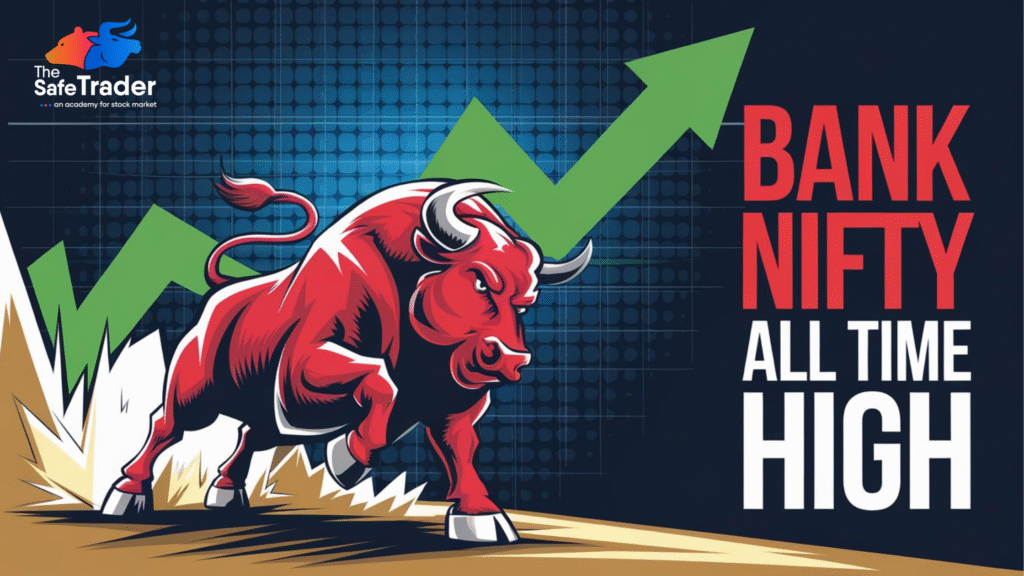
The Indian banking sector is now shining bright in the bullish world as the Bank Nifty climbed to yet another all-time level of 55,461 on 21st April 2025. This surge, with momentum from the splendid Q4 earnings, buoyant credit growth, and renewed interest from foreign investors, denotes strong fundamentals and continuous investor confidence in the Indian banking story. Here, we shall take a deep look at what was backing this surge, which banks are leading the charge, and what all traders and investors should watch for next. Market Recap: What Happened Today? Opening Bell: The index opened strong at 54891.25, fuelled by global cues and positive sentiment in the domestic market. Intraday Range: Bank nifty made an intraday high of 55461 before closing right around that mark. Volume Spike: A lot more volume was seen today compared to the averages, indicating aggressive and active participation by institutional and retail investors. Top Gainers in Bank Nifty HDFC Bank was able to achieve great, almost 2.7%, results, thanks to improved margins and solid advances in the increased interest income. ICICI Bank benefited from good post-results behavior, thanks to good NIMs and expansion in the loan book. Axis Bank and Kotak Bank gained over 1.5% due to positive sentiment and improving cost-to-income ratios across the sector. IndusInd Bank and Federal Bank also rallied in anticipation of Q4 results. The Key Drivers Behind This Rally 1. Strong Q4 Results The earnings momentum started from HDFC Bank and ICICI Bank, which, both in fact, delivered strong results above expectations. Major positives are as follows: 2. Fresh FII Buy Foreign Institutional Investors have returned with a vengeance into the Indian equities market, with banks being a favorite play. The money inflows form an important liquidity cushion, elevating valuations and sentiment. 3. Credit Growth & Digital Lending Boom Whenever RBI data speaks of growth in double digits, be it credit growth mostly of retail & SME nature, it fortifies yet another example of the rise of digital loans along with fintech partnerships breathing yet again into this whole sector of traditional banks. Any Risks Ahead? Although the rally appears to be on solid ground, the following areas will be subject to caution: However, a very healthy cushion exists from their strong balance sheets, large provisioning buffers, and much-improved cost efficiencies. What Are Analysts Saying? “The Bank Nifty’s breakout above 55,000 opens up potential for a rally towards 56,000–56,200 in the near term,” — said a senior technical analyst at Motilal Oswal. “Valuations are not stretched yet, and continued earnings upgrades may fuel further upside,” — noted a fund manager at SBI Mutual Fund. What to Watch Next? Coming up next are banking earnings: for Kotak Bank, SBI, and the smaller private/public banks. RBI Policy: Any dovish hints or pause in rate hikes would provide tailwind. Global Macro Events: Oil prices, US inflation data, and Fed speak may influence short-term sentiment. Conclusion Bank Nifty’s new high isn’t purely technical: It deeply reflects the bank sector development in India transforming itself structurally towards adapting to the digital, macroeconomic, and regulatory shifts. As it drags through the earnings season and with buoyant credit growth, it may well scorch new highs in the weeks to come. Markets are moving — are you? Connect with The Safe Trader Academy and trade smarter.
Turn Expert Moves Into Your Profits
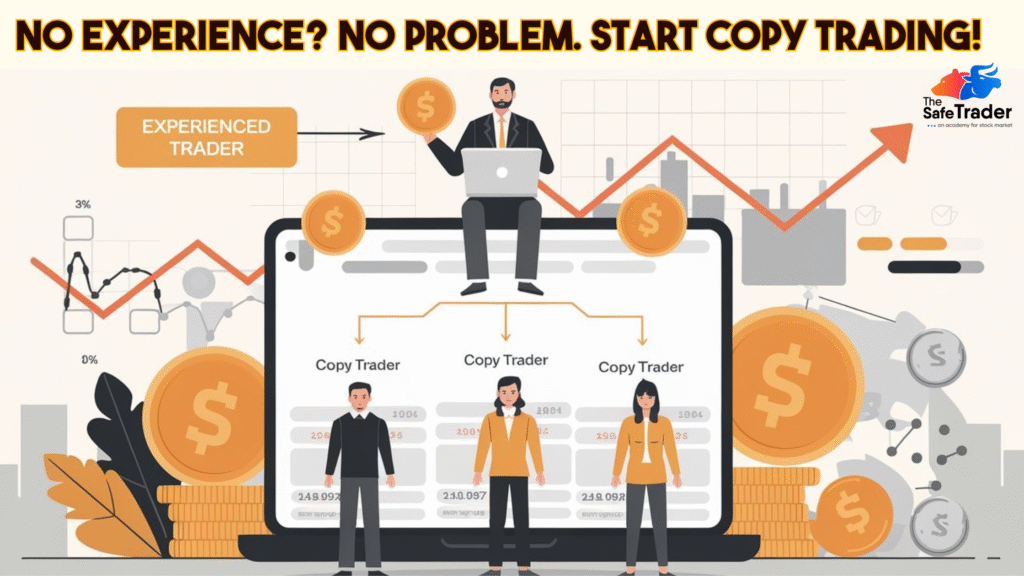
The contemporary financial landscape is in constant change. Within this context, Copy Trading, as it is popularly known, is a game changer for individuals interested in profiting from the expertise of professional traders without active portfolio management. Thanks to copy trading, it now also opens its doors to trading for beginners and investors who often find themselves against time. Equipped with only a mouse and minimal initial capital, anyone can now invest like a pro. This article discusses the other considerations for copy trading, including its workings, advantages, disadvantages, and tips for success. What is Copy Trading? Copy trading may be defined as an automating trading system whereby investors copy the trade of a professional trader with years of experience and success. The trade of buying or selling an asset made by somebody you have chosen to follow will trigger an automatic buy or sell entry in your own trading account at that same moment in time. In this way, you benefit from all of the potential gains or losses alongside the professional, without putting any thought into the trading decision whatsoever. Thus, copy trading tries to resolve the problem that retail investors meet in getting nearer to professional traders. It works by linking the account of the copier with that of a trader who has been selected purposely. All actions of the professional trader are then replicated in the copier’s account in proportion to the amount of capital allocated. If, for instance, the trader you copied would put 5% of his portfolio into a certain stock, you would also allocate the same proportion to your account. This, therefore, renders copy trading a passive but really smart investment strategy. How Copy Trading Platforms Work Copy trading is an activity that requires an investor to sign up with copy trading platforms or brokers. Below is a quick summation of how it works: Step 1: Register on a Copy Trading Site Platforms like eToro, ZuluTrade, NAGA, and MyFXBook provide good interfaces to browse, analyze and select traders to copy. These platforms aggregate various traders with diverse strategies and performance tracking. It helps copiers know what to do before starting. Step 2: Analyze Trader Profiles All traders on a copy trading platform have an extended profile by virtue of which detailed data is found about their trade performance using different assets, win rates on trades, drawdown levels, risk scores, historical returns, etc. This helps copiers filter and compare traders on a basis of such criteria, such as profitability, number of copiers, trading style, and so on. Step 3: Capital Allocation Whenever a trader is selected by the copier, the copier allocates towards copying that trader part of his total capital. The amount allocated can be altered over time in accordance with the copier’s preferences and risk appetite. Step 4: Operation of Trading Automatically Any time that the copied trader opens, changes, or closes a position, the same action performs automatically within the copier’s account. The amount of capital the copier allocated determines how the trades are proportioned to the copier and ensures that the returns (and losses) are in sync with the chosen trader’s performance. Step 5: Monitoring and Changes Copy trading is mostly automated. It is thus crucial for copiers to keep a close tab on how their selected trader(s) do from time to time. Investors have the option of halting copying, reallocating capital, or changing a certain trader if their performance does not meet the expected outcome. Check Out These Successful Copy Traders! Check Copiers, Return History, Profitability, Leverage, and Risk to choose the right trader Types of Copy Trading Models Modified forms of copy trading are available to accommodate investors’ different needs in some cases. This flexibility is helpful when one invests in the model that matches one’s goals and risk exposures. 1. Manual Copy Trading For manual copy trading, investors carry out the analyses and selections of the trades they want to copy. This may be considered the main drawback of having less control over what trades will be copied. But on the flip side, it requires some level of understanding of the markets and perusing every opportunity for trading. 2. Automated Copy Trading This is indeed the most popular and easiest model, wherein all trading decision making and thus their executions are immediately mirrored in the account of the copier. The moment a trader is chosen and the capital allocation made, the system takes control of everything in real time. 3. Social Trading As an extension of copy trading, social trading brings community features to the service: it allows users to copy trades but can also interact, discuss strategies, and share insights into market trends with other traders. In combining the benefits of copy trading with those of collaborative learning, social trading yields an improved form of copying. Key Benefits of Copy Trading 1. Perfect for beginners: Beginners can skip most of the rocky process of learning by depending on the skill of professional traders. Copy trading reduces the engagement of much technical analysis or even deep market knowledge. 2. Save Time and Energy-it is hassle-free for pre-occupies individuals without time to study markets or plan trading strategies. 3. Obtaining Different Strategies-It allows all investors to experiment with different trading styles like day trading, swing trading, or longer investment by copying more than one trader using another approach. 4. Spreading the Risk-Investors can follow different traders or approaches and thus have more risky portfolios to reduce the overall risk associated with depending on a particular strategy. 5. Transparency with Real-Time Insights: Most copy trading platforms offer a complete transparency perspective with a clear record of historical data performance, risk levels, and trading patterns of the professional traders, which provides the necessary foundations to make informed decisions. 6. Learning It also becomes an application through which beginners can learn the reasons for specific trades by watching expert proceedings about market trends. Challenges and Risks in Copy Trading If copy trading has a lot of benefits, it still poses
Indian Stock Market : Key Insights and Trends in 2025
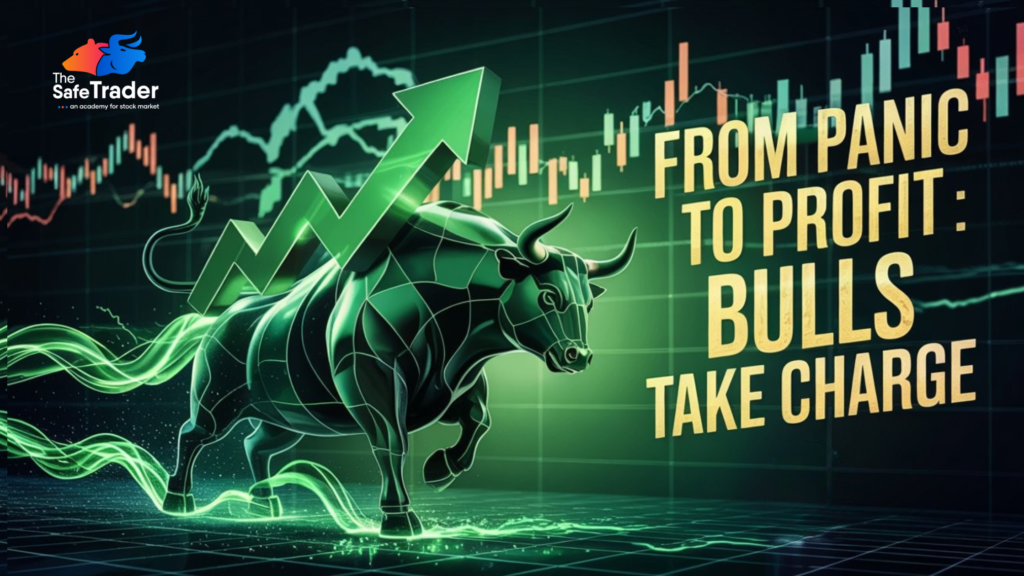
Market Overview The Indian stock market has finally started to recover after its long stagnation. Key indices like Nifty 50 have rallied in recent trading sessions, with many large stocks also giving spectacular returns. While the market faces challenges, such as the IT sector not doing very well, it appears to be on the mend, with sectoral recoveries, positive FII inflows, and global cues regarding the price movements of gold and crude oil aiding the recovery. 1. Nifty 50: Strong Recovery of 10% Nifty 50 Closing (April 17, 2025): 23,851.65 The Nifty 50 has bounced back against the lows by 10 percent in the last seven days to close at 23851.65 on April 17, 2025. This rally has been backed by sectoral support largely coming from banking, energy, and metals. The more robust the rally, the more the market seems to be stabilizing after prior corrections. 2. Reliance Industries: Strong Uptick of 15% Reliance Industries : ₹1,274.50 (₹35.20 or 2.84%) 7-Day Growth: +15% Reliance Industries surged 15 percent in value over the past week to close at Rs 1274.5 per share, benefiting from a diversified business model, covering telecom, retail, and energy. Rising crude oil prices have also buffeted the $200 billion company’s energy and petrochemical arms. 3. FII Flows: Positive Sentiment Returns Foreign Institutional Investors (FII) have started to return to the Indian stock market, signaling a shift in sentiment. After a period of cautious outlook, the return of foreign capital has been one of the key factors driving the market’s recent uptrend. This renewed interest in Indian equities reflects growing optimism about India’s economic recovery. 4. Recovery in Key Sectors: Sectoral Rebounds Those sectors which experienced a lot of losses during the earlier months are now galloping towards recovery. Well among the key sectors: Banking Sector: The three banks- HDFC Bank, SBI and ICICI Bank are continuously posting lifetime highs, thanks to excellent earnings and brightened expectations on credit growth. Energy Sector: With the revival of crude oil prices, Reliance Industries and all other energy companies captured a golden chance. Metals: Companies in metals will immediately get an upward thrust after the international commodity price recovery. 5. Global Factors The Tariff War Comes to a Standstill, Energy Elements Requisite for Crude Oil Recovery The tariff war between major global economies has become a mere shadow, maintaining a low level of uncertainty in the global market. Its halts will encourage growth in trade-sensitive sectors. Moreover, crude oil price recovered to $64.68 per barrel and will cultivate famous winds for energy crews like Reliance Industries and ONGC. 6. Gold Price Soars to All-Time Highs Gold Price: ₹100,000 per 10 grams Gold has reached its all-time maximum of ₹100,000 for 10 grams. Currently, the buzz in gold prices is propelled mainly by global economic discontinuities, inflation fears, and a move towards safe haven assets. With a mass inflow of global investors into gold, it would perhaps mean a general caution towards economy-related issues. 7. Peaked Crude Oil Prices Crude Oil Price : $64.68 per barrel (+2.21%) Moving up in price, crude oil now stands at $64.68 per barrel and up 2.21%. Supply-side disruptions combined with recovery in general demand support the rise in crude prices; thus, benefiting companies in the energy chain and oil refining sector, among which Reliance Industries may be benefited in the process. 8. Strong Performers in the Banking Sector The banking sector has become one of the strong performers in 2025, with several top banks reaching fresh lifetime highs. These banks have rewarded investors with 18% returns in 2025 so far, touching new all-time highs with HDFC Bank, ICICI Bank, and State Bank of India. Axis Bank, specifically, was a good performer, giving 28% return during 2025, thanks to solid growth in retail banking and digital adoption, along with a growing loan book. 9. IT Sector: Infosys and TCS in Trouble: A major troublemaker for the IT sector, Infosys and TCS have seen 28%-to-30% losses so far in 2025. Several reasons to account for these underperformances are: Global Economic Slowdown: Poor demand for IT services in key international markets, such as the US and Europe. Increasingly Competitive: Undercutting competition from newly emerging markets, with particular reference to Eastern Europe and Southeast Asia. Technological Disruption: The automation and Artificial Intelligence Highway is reducing demand for traditional IT outsourcing services. Conclusion: A Dynamic Market in Transition The month of April 2025 has seen a remarkable turnaround in the Indian stock market owing to surges in one sector or another, favorable performance from banks, and raising investor confidence. The last seven trading days have seen Nifty 50 recover by 10%, led by banking and energy sector stocks on a rally that has seen Reliance Industries gain around 15% from recent lows with gold touching a new all-time high. The market will not be kind to all sectors. While banking, energy, and commodities may see positive technicals to continue in their upward momentum, it is the visible weakness of the IT sector that serves as a reminder to investors of the importance of macroeconomic and technological disruption forces in judging the performance of a certain stock. Investor opportunities versus challenges remain. Investors must focus on maintaining a diversified portfolio and sectoral analysis while dealing with such an extraordinary market.
Why Gold Is Booming: Fundamentals, Buyers & Forecasts

Gold has always been an asset and it is going to be in the next heights in 2025. In India, gold would have already reached 1,00,000/- rupees per 10 grams with a global price touching $2,000 an ounce for this precious metal as it quickly fills in the gaps by following inflation in the world, risks related to geopolitics, and steady central bank buying. So, why arrange such extreme gains for gold, and what does it hold for investors? Let’s unravel it all. Understanding the Surge in Gold Prices In April 2025, the price of gold was at an all-time high and is the result of several factors that have contributed to this increase over many years. However, to really appreciate the significance of this increase, we need to examine some of the key drivers: Latest Gold Trends (2025) The Fundamentals of Gold Gold holds attraction for its intrinsic value and function as a safe-haven asset. Unlike paper currencies, gold exists in finite quantities, and its value is preserved over time owing to its inverse relation with scarcity. The following are the primary reasons behind gold retaining its ever-important place in the global economy: 1. Store of Value It is mostly classified as a hedge against inflation and uncertain economic times. Investors use gold to preserve wealth against inflation weakening the currencies. 2. Demand from Central Banks Countries such as China, Russia, and India have also been continuously increasing their gold reserves over the last decade. Demand for gold from the central banks has surged as these countries have the will to lessen their dependency on the dollar and diversify foreign reserves. 3. Cultural Significance Gold in India and China has both investment value and immense cultural significance. In these countries, gold remains an attractive investment as it becomes prevalent during various festivals and wedding ceremonies, standing as a symbol of wealth and prosperity and keeping demand strong year after year. Historical Performance of Gold To understand the recent surge, it’s helpful to take a look at how gold has performed historically. Here’s a snapshot of the past few years: Gold saw its largest surge in 2020, driven by the global pandemic, stimulus packages, and low interest rates. But the momentum didn’t stop there. 2024 witnessed a 27% price increase, as the global economic landscape remained unstable. Who’s Buying Gold? Now, central banks continue to retail investors and institutional purchasers: This share of consumers will be analyzed according to: 1. Central Banks Countries like China, Russia, and India purchased massive amounts of gold. In 2024 alone, central banks amassed 1,180 tons of gold, creating a new record in this type of gold demand. The consumption trend reflects the awakening interest in diversifying economies away from the U.S. dollar and reinforcing their countries’ foreign exchange reserves. 2. Retail Investors Gold has been the best investment for centuries, especially in countries like India and China, where gold is revered culturally and financially. Demand continues to be reinforced as the festivals and weddings are upon us. Furthermore, gold ETFs are now fast gaining acceptance among those who want to invest in gold in a more accessible and liquid form. 3. Institutional Investors Now, more and more institutions, hedge funds, and pension funds in particular, are moving into gold. Part of the reason for it is that institutions want to hedge against inflation and/or volatility in market conditions, especially during periods of economic uncertainty. Why Are Gold Prices Soaring? Gold’s 2025 surge can be attributed to several macroeconomic factors: 1. Inflation One of the major factors is inflation. The rise in global inflation levels erodes real values of fiat currencies. Hence, gold served as a store of value in such circumstances, attracting investors wishing to preserve their wealth. 2. Geopolitical Tensions Gold benefits when geopolitical clouds gather: from the Russo-Ukrainian war to tensions in Asia. Investors acquire gold as a safe-haven asset whenever confrontations impact traditional markets. 3. Weakening U.S. Dollar A weak dollar in the U.S. is favorable toward gold in the eyes of foreigner investors. With the dollar’s strength waning, gold becomes cheaper in foreign currency terms, thus enhancing global demand. 4. Low Real Interest Rates Though some interest hikes were instituted by the Central Banks, many economies with the U.S. and Eurozone still have negative real rates which is a cause for concern. Profitable avenues for investment with no opportunity cost of holding such low-returning assets will find a fair market through gold. Where Are Gold Prices Headed in 2025? Gold’s upward trajectory seems likely to continue. Based on current market conditions, here’s the outlook for the next few months: Is This Surge a Sign of a U.S. Recession? Though gold price rises continue to raise questions regarding the overall economic outlook, many investors are worried about a looming U.S. recession; hence, gold, a safe-haven asset these days, tends to be favored. Normally, gold performs well during economic downturns, making it a prudent investment during uncertain times with recession apprehensions. Conclusion: What Does the Future Hold for Gold? Gold continues being a resilient asset-class with a long-term implication for 2025 being promising. Though short-term wiggles may arise from interest rate increases or stock market rallies, the macroeconomics indicates that gold is going to continue doing well. Whether you are drawn as an individual investor or central bank or institutional buyer, knowing the components that drive gold price is central to surfing this market. High inflation, geopolitical uncertainty, and low interest rates probably will continue pushing gold prices higher, thereby making it a lucrative asset for a long time ahead.
Why Is The Safe Trader Academy One of India’s Top Stock Market Training Institutions?
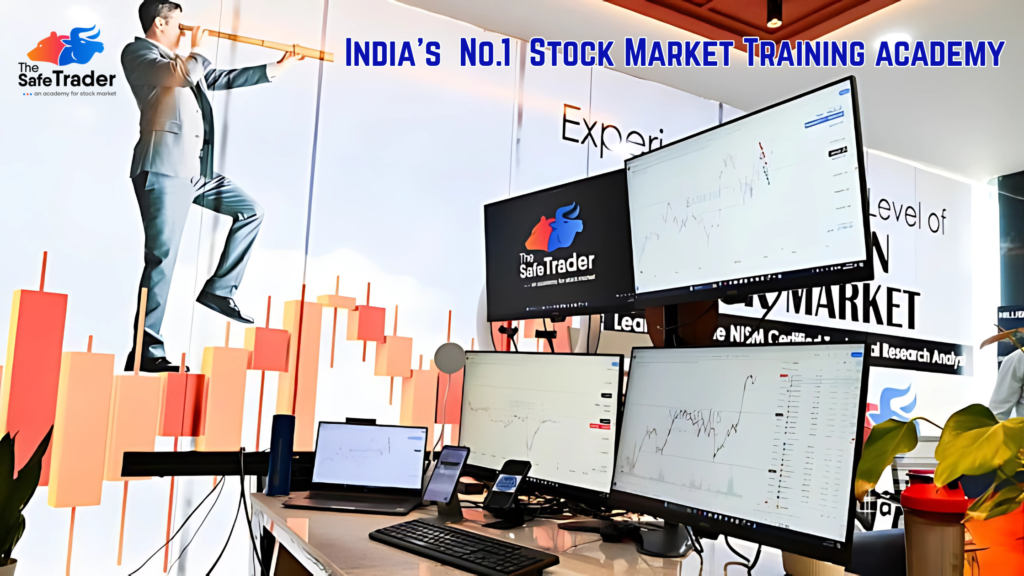
When it comes to mastering the art of stock market trading, choosing the right academy is essential. The Safe Trader Academy has become one of India’s No.1 Best Stock Market Training Institutions, recognized for its comprehensive courses, experienced mentors, and proven track record of success. Additionally, it is widely regarded as Hyderabad’s top choice for stock market education. Here’s why it stands out as one of the top choices for aspiring traders. 1. NISM Certified and AMFI Registered Trainers At The Safe Trader Academy, we prioritize quality education by offering training from NISM Certified Research Analysts and AMFI Registered Mutual Fund Distributors. These certifications ensure that our mentors bring up-to-date, credible, and professional insights into the classroom, providing students with the highest standards of training in the stock market. 2. Over 2,500+ Successful Students Trained With more than 2,500+ students trained and a growing presence across India with 5+ branches, The Safe Trader Academy has helped countless individuals transform into skilled and confident traders. Our alumni’s success stories are a testament to the effectiveness of our training programs, and we continue to equip new students with the tools they need for success. 3. Flexible and Comprehensive Learning Options Whether you’re a beginner or an experienced trader, we offer courses that cater to your specific needs. Our curriculum covers everything from basic trading principles to advanced techniques like Options Trading, Forex Trading, Crypto Trading, and Equity Investing. 4. Direct Mentorship from Our CEO One of the standout features of The Safe Trader Academy is the direct mentorship from our CEO. This exclusive opportunity allows students to gain invaluable insights from an industry leader, learn about the latest market trends, and get personalized advice to shape their trading journey. It’s a unique offering that sets us apart from other training institutions. 5. Live Market Support and Daily Tips At The Safe Trader Academy, we ensure that our students stay on top of market trends. Through live market support and daily trading tips (especially for Options & Forex), students are able to stay updated with real-time developments. This hands-on support helps build their confidence and enhances their decision-making skills. 6. Access to Zoom Recordings and Flexible Batch System We understand that life can get busy, and flexibility is important. That’s why we offer Zoom recordings of all classes, so students never miss out on important lessons. Moreover, our flexible batch system allows you to revisit courses as many times as needed without incurring additional costs. This ensures continuous learning and growth at your own pace. 7. Exclusive Telegram Channels for Community Interaction As part of the course, students gain access to our official Telegram channels, where they can interact with peers, share insights, ask questions, and keep up with the latest market updates. This creates a community of like-minded individuals who support and motivate each other in their trading journey. 8. Real Classroom Exposure At The Safe Trader Academy, we believe in transparency and interaction. Our real classroom exposure offers students the chance to walk in, observe, and directly communicate with our current students and mentors. This open environment fosters collaboration and provides an authentic feel of what it’s like to be part of our learning community. Why Choose The Safe Trader Academy? Conclusion The Safe Trader Academy, recognized as India’s No.1 Best Stock Market Training Institution and Hyderabad’s top choice for stock market education, is not just another training institute; it is a trusted partner in your journey to becoming a successful trader. With a strong emphasis on practical learning, direct mentorship, and a flexible learning environment, we equip our students with the knowledge and tools they need to thrive in the dynamic world of stock trading. Whether you’re just starting or looking to refine your trading skills, The Safe Trader Academy is your one-stop destination for mastering the stock market.
Why 93% of Retail Traders Lose Money in Options Trading? – And How You Can Avoid It
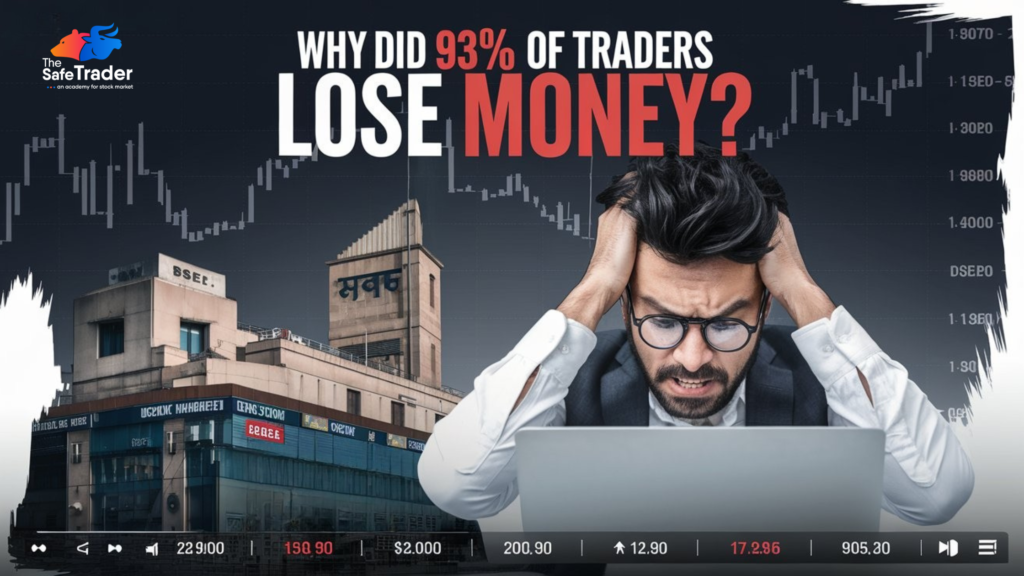
There was a shocking report from SEBI (Securities and Exchange Board of India) stating that 93% of retail traders in the F&O (Futures & Options) segment are incurring losses. These are not just figures but instead depict the actual happenings behind those green screenshots and success stories flooding your feed. Adding to that, more telling statistics at the state-level were revealed. The top states with maximum trading losses are: These are not backward states. They are the home of several of India’s tech hubs and business centers, and some of the highest per capita income groups reside here. So how come even these educated and financially literate populations have not been able to make it in the stock market? The Illusion of Success in Trading Let’s be honest. Social media has made trading look like a “laptop lifestyle.” Quick profits. Fancy setups. Flashy cars. But behind that illusion is a reality full of anxiety, losses, and debt. The truth is, trading is simple—but not easy. According to Mallinath Mulage, Founder & CEO of The Safe Trader Academy, the problem lies not in the stock market itself but in the mindset, approach, and education level of traders. Below is a deeper dive into his 20 critical observations—real reasons why traders are consistently losing money. 1. Traders don’t spend enough time to learn A lot of people go for options trading after getting a glimpse of the venture from some YouTube videos or a webinar. But options trading is not something that can be learned over the weekend. It is a combination of market knowledge, technical analysis, psychology, and strategy-making. Would you ever want to board a plane having learnt just a couple of Instagram Reels about flying? 2. Traders want to make quick money People are drawn to options on account of the potential for high returns. Yet high returns imply high risk. The urge to double money in one trading day leads traders to ignore the basic rules of trading and indulge in impulsive trades. Fast money mindset = fast losses. 3. Traders are greedy Traders restricting their positions, yet hoping for more profits, almost always are losers as positions reverse and turn against them. Many traders don’t book profits; instead, they double the stake, hoping for recovery on a trade that has already gone against them. Greed allows you to stay in the market longer than you ever should. 4. Emotional Fear, greed, hope, and regret are the four demons of trading. Every time emotions step into the decision-making process, discipline is thrown out of the window. Most retail traders fail to have a plan; they merely react to every single candle on the chart. Emotion + money = disaster. 5. Not gaining required skills Successful trading is about multi-skilled learning: reading charts, understanding market sentiment, knowledge of risk management, and so on. Skipping these steps is like going to war without the weapons. “Skill pays the bills.” 6. Not maintaining stoploss Stop loss is your safety net: not placing it or moving it, hoping that the trade will “come back,” is perhaps the fastest way to blow your account. A stop loss is not an option; it is a matter of survival. 7. Naked options buying Most new traders just buy calls or puts without bothering about volatility (VIX) or time decay (theta) or direction. Buying options with not a care about strategy is akin to gambling at whatever roulette does. Trades with low probabilities generate high stress. 8.Wrong entry and wrong exit It is common to enter too late or exit too early or late. Without clear rules about when to enter and when to exit, you will be gambling. It is not timing that is everything; it is the only thing. 9. Don’t want to learn from the mistakes Too many traders make the same mistakes over and over again: leverage too much, hold onto a losing trade, hold on for news… Past trades are never reviewed, so nothing changes. Insanity is repeating the same thing over and over and expecting different results. 10. Overtrading Too many trades within a day cloud a trader’s judgment and drain him emotionally. Some traders refuse to stop even while on a losing streak; they instead continue trading to “recover.” Overtrading=death by a thousand cuts. 11. Depends on tips People blindly follow Telegram/WhatsApp tips without understanding the rationale behind it. Even if a tip works once in a blue moon, a false tip would wipe out weeks of profit. If tips worked, then everyone would be a billionaire. 12. Social media influencer Instagram reels and YouTube videos flash across the screen with huge profits but hardly show losses. It does not represent what trading truly is, thereby setting up unrealistic expectations. Social media shows highlights, but never the actual game. 13. No Trading Journal Not maintaining one means you don’t know what works for you and what doesn’t. A trading journal inculcates self-awareness and hones your edge. What gets measured gets improved. 14. No Mentor or Trade Buddy Without someone to guide you, it’s likely you will take much longer to learn or, worse, pick up a few bad habits. A mentor will help you avoid rookie mistakes and hold you accountable. All pros were once beginners, and so should you. 15. No Back testing You need to test your strategy on historical data before going live. If you don’t know how your set-up is performing over maybe 100 plus trades, you are literally trading in the dark. Never risk real money on untried strategies. 16. Not able to find the right institute to learn offline There’s every online video and free content and then there is the structured in-depth offline education hard to find. They even lack hands-on guidance. Learning is as personalized as it comes. 17. Taking risk beyond the risk appetite Big bets might hit big on a single trade jackpot; however, jackpots are often lost in each losing trade. Be in it for life, not
Gold Prices Hit All-Time High, Surpass ₹96,000 per 10 Grams Mark

Gold prices soared to an all-time high on Friday, 11 April, 2025, crossing the ₹96,000 per 10 grams threshold for the first time in history. The value of the metal skyrocketed by ₹6,250, based on intense jewellery buying and speculative interest by investors against the background of growing worldwide uncertainties. Price Movement & Market Context Gold with 24K purity reached ₹96,450 per 10 grams, which is a record high. The steep rise of ₹6,250 in a single day brought an end to a four-day losing spree, the highest single-day increase in more than two months. Gold futures also scaled new peaks, with June delivery contracts rising to ₹93,736 per 10 grams on the Multi Commodity Exchange (MCX). Factors Driving the Surge The surge in gold prices comes amid escalating global trade tensions, particularly between the U.S. and China. U.S. President Donald Trump’s decision to increase tariffs on Chinese imports has sparked fears of a full-scale trade war,boosting demand for gold as a safe-haven asset. The increasing probability of an economic downturn, weakening dollar, and U.S. Treasury selloff have also fueled demand for gold on both the domestic and foreign fronts. Silver Price Surge Silver prices also increased sharply, rising ₹2,300 to ₹95,500 per kilogram. The rise in the silver market is a reflection of the increase in gold, fueled by global uncertainties and the rush to precious metals. Global Gold Market Trends Gold prices recorded a new record high of $3,237.39 an ounce in the international market with Comex gold futures touching a high of $3,249.16 an ounce during the Asian market trading hours. Geopolitical uncertainties, such as the U.S.-China trade war, are still propelling gold’s attraction as a haven asset. Emerging market central banks have been acquiring gold at an unprecedented rate, further driving demand. Expert Opinions Financial analysts and companies such as UBS are forecasting sustained strength for gold over the next few months. Gold will continue to be a fundamental asset during uncertain times, spurred by global economic problems and continued diversification out of the U.S. dollar, UBS believes. What This Means for Investors For investors, the present spike in gold prices is both opportunity and risk. While gold is still a good hedge against economic turmoil, investors who are new to the market must exercise caution since prices are at record levels. Investors should plan on the long-term and keep themselves updated on developments around the world. Conclusion Gold’s remarkable rise above ₹96,000 per 10 grams underscores its role as a key safe-haven asset in times of uncertainty. With geopolitical tensions, economic anxiety, and a declining U.S. dollar fueling its advance, gold can expect to experience robust demand in the coming months.
Trump Announces 90-Day Pause On Reciprocal Tariffs, Except China
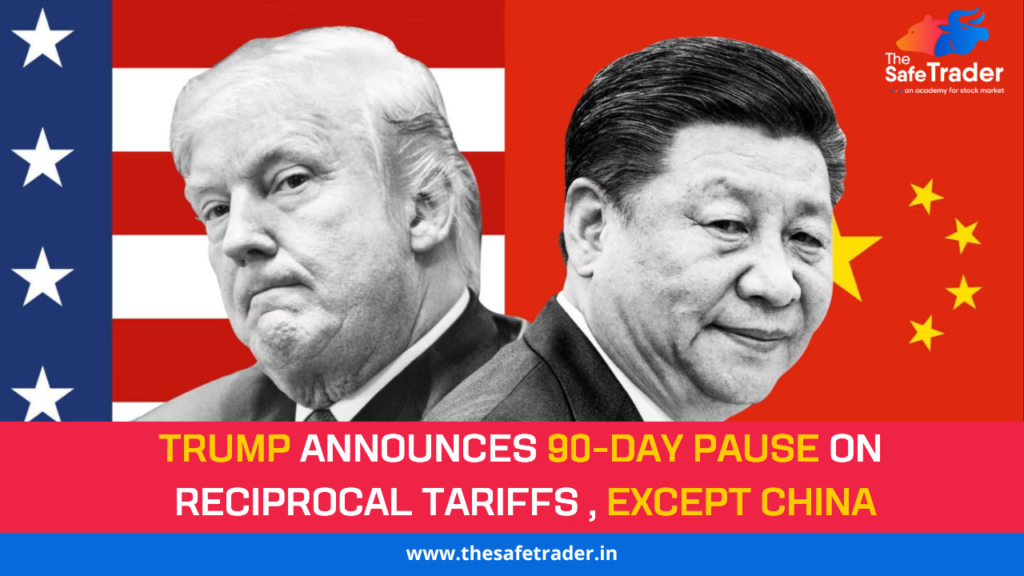
On Wednesday, in an unexpected shift of strategy, U.S. President Donald Trump announced a 90-day pause on sweeping tariffs for most countries, except China. Initially, the tariffs were introduced to combat what Trump perceived as unfair trade imbalances. However, after intense pressure from business executives and political figures, and growing concerns about the potential repercussions of a global trade war, Trump decided to soften his stance. The pause, which will last for 90 days, will witness a substantially lower tariff of only 10 percent on nations that had negotiated with the U.S., while China will witness a much more confrontational tariff hike. Trump imposed higher tariffs on China to a whopping 125 percent from the already announced 104 percent. This action is largely a response to China’s trade policies, which Trump has over and over again called “unfair” to the U.S. economy. Why the Change of Heart? The sudden reversal followed increasing unease in the U.S. Treasury Department about the condition of the bond market. Treasury Secretary Scott Bessent and White House economic aides allegedly briefed Trump on the spreading selloff in U.S. Treasury bonds, which had sent shudders through world financial markets. For days, Trump had defied demands from both fellow Republicans and business leaders to stand down from the tariffs, citing the imperative of addressing the trade imbalance. But it appears that the turmoil in the bond market was too large to overlook. In his announcement, Trump acknowledged that the decision to pause the tariffs was made on impulse. “The bond market is very tricky… but yeah, I saw last night where people were getting a little queasy,” he remarked during a press briefing. This comment suggests that the president’s decision wasn’t fully planned out, but rather a reaction to the emerging financial instability. What Happened in the Markets? The tariff pause news had a sudden and dramatic impact on U.S. financial markets. Shares rallied as investors welcomed survival of the creditors’ plan. But within minutes of the announcement, the Dow Jones Industrial Average rose by about 2,500 points, reaching a near 8 percent daily increase. Nasdaq, the tech-heavy index, jumped 12.2 percent, its best performance in 24 years. The S&P 500 also rose by a big 6.0 percent to 5,281.44 points. Besides the rally in the stock market, oil prices rose over 4 percent as the hope of easing trade tensions cut down on worries about a global economic slowdown. The U.S. currency also gained strength as investors felt a renewed optimism that had previously been worried about the devastating impact of a prolonged trade war. These market fluctuations highlight just how closely interwoven tariffs, trade policy, and investor sentiment are. The rapid fluctuations in bond markets and the increased fear of recession were all it took to get the United States administration to move, and by doing so, Trump gave the world economy a welcome respite, if only temporarily. The Continued China Factor Even with the relief provided to most nations by the temporary tariff reprieve, Trump’s move to raise tariffs on China represents a continued point of contention in the trade war. Trump’s tough talk against China, especially his remarks regarding President Xi Jinping’s pride and the nation’s purported manipulation of world markets, indicates that the trade war with China will continue to be a point of emphasis in U.S. foreign policy. The 125 percent tariff hike is viewed as an overt effort to pressure China into agreeing to a good trade agreement with the U.S. Though Trump was hopeful that China would ultimately “figure it out,” the dramatic rise in tariffs might also boomerang by aggravating U.S.-China tensions further and damaging the global trading system. Conclusion: Temporary Relief Amid Continued Uncertainty Trump’s announcement to pause tariffs for 90 days offers a temporary sigh of relief for global markets, particularly the U.S. stock market, which had been under intense pressure from trade-related concerns. The dramatic market rebound following the news signals the significance of the tariff pause in alleviating investor fears of an impending global recession or trade war. But this action does not solve the root problems of U.S.-China trade relations. The tariff hike on China indicates that Trump’s tough approach to China will continue, and the trade war is far from over. In addition, although a pause in tariffs could bring temporary stability, the long-term impact on global trade and the economy is unclear. As financial markets respond to this latest turn of events, one thing is certain: the fate of the trade war will rest largely in the hands of the future of U.S.-China talks and the wider geopolitics. Investors will be watching closely over the next 90 days, praying that the temporary reprieve from tariffs will be sufficient to avoid a wider economic crisis.
China Strikes Back: 84% Tariffs on U.S. Goods
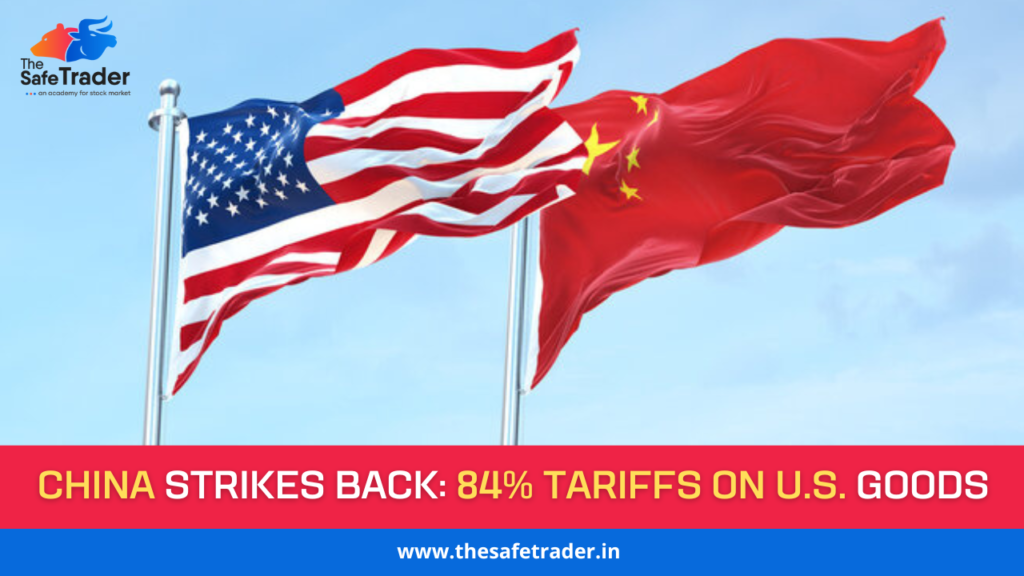
In a dramatic intensification of the U.S.-China trade war, China has said it will impose 84% tariffs on U.S. products, a major turn in the current conflict between the two world’s largest economies. The action follows directly on the heels of the U.S.’s recent imposition of 104% tariffs on Chinese imports, a move that could signal a further intensification of economic tensions with potentially global implications. The Catalyst: U.S. Trade Policies and the Escalating TensionsThe tensions between the U.S. and China have been brewing for decades, fueled mainly by fear of trade deficits, intellectual property theft, and the economic practices of China. Recent months have seen the U.S. ramp up its actions to push China to address these concerns, levying massive tariffs on Chinese goods. China, for its part, has retaliated in turn with measures of its own, leading up to the current announcement of an 84% tariff on American goods. The move is as much a political as an economic maneuver, reasserting China’s position that it will not be bullied into responding to U.S. pressures. Impact on the Global Economy The instant impact of this tariff hike is being experienced in world financial markets. Investors are being cautious, and leading share indices in the U.S. and Europe have witnessed falls following increasing uncertainties. The stock market volatility reflects the larger concerns surrounding the world economy. Oil prices have also seen steep declines, as the trade war remains to hang over the prospects of global growth. In China, the yuan dropped to its lowest level in close to two years, raising concerns of a continued slowdown in the second-largest economy in the world. The Long-Term Outlook: A Prolonged Economic Battle The future is uncertain. While neither country has indicated a willingness to fold, the economic impact of these rising tariffs could be catastrophic. Experts see the prolonged trade wars affecting businesses and consumers in a big way. For multinational corporations, this translates into increased costs of goods, supply chain disruptions, and possible changes in market dynamics. For consumers, it might mean increased prices for common items, especially in sectors such as technology, automobiles, and consumer goods, where Chinese and American companies have strong trade relationships. The Role of Governments and the Potential for Negotiations Although the situation is still tense, there is still a possibility of a diplomatic solution. There have been several rounds of talks between the U.S. and China throughout the years, and even though there is currently a standoff, there are still possibilities for talks that can diffuse the conflict. Any such agreement, however, would involve major concessions from both parties, and thus a solution is unlikely in the near future. What Should Investors and Businesses Do? In light of these developments, investors are advised to exercise caution and maintain diversified portfolios to shield themselves from the volatility triggered by the trade war. For businesses, especially those involved in global supply chains, it’s crucial to reassess operational strategies and explore alternative sourcing options to minimize the impact of these new tariffs. The threat of further escalation cannot be ruled out, and businesses need to prepare for a longer duration of uncertainty. Flexibility and an emphasis on long-term objectives will be the key as the global economic scenario continues to change. Conclusion China’s imposition of 84% tariffs on U.S. goods marks a significant chapter in the ongoing trade war, with profound implications for both nations and the global economy. While the full impact remains to be seen, it’s clear that the stakes are high, and the outcome of this conflict will shape global trade for years to come. As businesses, investors, and governments navigate this uncertain terrain, it’s more important than ever to remain informed and adaptable in the face of these escalating trade tensions.
